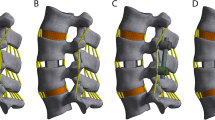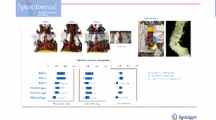Abstract
Purpose
To compare instrumentation configurations consisting of bilateral single or double rods and additional interbody cages (IBCs) at different levels in terms of Range of Motion (ROM) and distribution of von Mises stress in rods.
Methods
A previously validated L1-pelvis finite element model was used and instrumented with configurations consisting of single or double bilateral rods and IBCs at multiple levels. Pure moments of 7.5 N.m were applied to L1 in main directions in addition to a follower load of 280 N. Global, segmental ROM and distribution of von Mises stress in rods were studied.
Results
All configurations reduced segmental and global ROM from 50 to 100% compared to the intact spine. Addition of IBCs slightly increased ROM at levels adjacent to the IBC placement. The simple rod configuration presented the highest von Mises stress (457 MPa) in principal rods at L5-S1 in flexion. Doubling rods and IBC placement reduced this value and shifted the location of maximum von Mises stress to other regions. Among studied configurations, double rods with IBCs at all levels (L2-S1) showed the lowest ROM. Maximal von Mises stresses in secondary rods were lower in comparison to main rods.
Conclusions
Double rods and IBCs reduced global and segmental ROM as well as von Mises stress in rods. The results suggest a possible benefit in using both strategies to minimize pseudarthrosis and instrumentation failure. However, increased ROM in adjacent levels and the shift of maximal von Mises stress to adjacent areas might cause complications elsewhere.




Similar content being viewed by others
References
Kebaish KM, Neubauer PR, Voros GD et al (2011) Scoliosis in adults aged forty years and older: prevalence and relationship to age, race, and gender. Spine Phila Pa 1976 36:731–736. https://doi.org/10.1097/BRS.0b013e3181e9f120
Lertudomphonwanit T, Kelly MP, Bridwell KH et al (2018) Rod fracture in adult spinal deformity surgery fused to the sacrum: prevalence, risk factors, and impact on health-related quality of life in 526 patients. Spine J 18:1612–1624. https://doi.org/10.1016/J.SPINEE.2018.02.008
Charles YP, Ntilikina Y (2020) Scoliosis surgery in adulthood: what challenges for what outcome? Ann Transl Med 8:34
Godzik J, Hlubek RJ, Newcomb AGUS et al (2019) Supplemental rods are needed to maximally reduce rod strain across the lumbosacral junction with TLIF but not ALIF in long constructs. Spine J 19:1121–1131. https://doi.org/10.1016/j.spinee.2019.01.005
Ntilikina Y, Charles YP, Persohn S, Skalli W (2020) Influence of double rods and interbody cages on quasistatic range of motion of the spine after lumbopelvic instrumentation. Eur Spine J. https://doi.org/10.1007/s00586-020-06594-2
Charosky S, Moreno P, Maxy P (2014) Instability and instrumentation failures after a PSO: a finite element analysis. Eur Spine J 23:2340–2349. https://doi.org/10.1007/s00586-014-3295-x
Luca A, Ottardi C, Lovi A et al (2017) Anterior support reduces the stresses on the posterior instrumentation after pedicle subtraction osteotomy: a finite-element study. Eur Spine J 26:450–456. https://doi.org/10.1007/s00586-017-5084-9
Seyed Vosoughi A, Joukar A, Kiapour A et al (2019) Optimal satellite rod constructs to mitigate rod failure following pedicle subtraction osteotomy (PSO): a finite element study. Spine J 19:931–941. https://doi.org/10.1016/j.spinee.2018.11.003
Berjano P, Xu M, Damilano M et al (2019) Supplementary delta-rod configurations provide superior stiffness and reduced rod stress compared to traditional multiple-rod configurations after pedicle subtraction osteotomy: a finite element study. Eur Spine J. https://doi.org/10.1007/s00586-019-06012-2
Luca A, Ottardi C, Sasso M et al (2017) Instrumentation failure following pedicle subtraction osteotomy: the role of rod material, diameter, and multi-rod constructs. Eur Spine J 26:764–770. https://doi.org/10.1007/s00586-016-4859-8
Leszczynski A, Meyer F, Charles Y-P et al (2021) Development of a flexible instrumented lumbar spine finite element model and comparison with in-vitro experiments. Comput Methods Biomech Biomed Eng. https://doi.org/10.1080/10255842.2021.1948021
Roussouly P, Gollogly S, Berthonnaud E, Dimnet J (2005) Classification of the normal variation in the sagittal alignment of the human lumbar spine and pelvis in the standing position. Spine (Phila Pa 1976) 30:346–353. https://doi.org/10.1097/01.brs.0000152379.54463.65
ASTM F1537 - 20 Standard Specification for Wrought Cobalt-28Chromium-6Molybdenum Alloys for Surgical Implants (UNS R31537, UNS R31538, and UNS R31539)
ASTM F136 - 13 Standard Specification for Wrought Titanium-6Aluminum-4Vanadium ELI (Extra Low Interstitial) Alloy for Surgical Implant Applications (UNS R56401)
Blinded (2020) Validation of an instrumented lumbar spine finite element model. Under Rev
Rohlmann A, Neller S, Claes L et al (2001) Influence of a follower load on intradiscal pressure and intersegmental rotation of the lumbar spine. Spine (Phila Pa 1976) 26:E557–E561. https://doi.org/10.1097/00007632-200112150-00014
Dahl BT, Harris JA, Gudipally M et al (2017) Kinematic efficacy of supplemental anterior lumbar interbody fusion at lumbosacral levels in thoracolumbosacral deformity correction with and without pedicle subtraction osteotomy at L3: an in vitro cadaveric study. Eur Spine J 26:2773–2781. https://doi.org/10.1007/s00586-017-5222-4
Smith JS, Shaffrey E, Klineberg E et al (2014) Prospective multicenter assessment of risk factors for rod fracture following surgery for adult spinal deformity. J Neurosurg Spine 21:994–1003. https://doi.org/10.3171/2014.9.SPINE131176
Hyun S-J, Lenke LG, Kim Y-C et al (2014) Comparison of standard 2-rod constructs to multiple-rod constructs for fixation across 3-column spinal osteotomies. Spine (Phila Pa 1976) 39:1899–904. https://doi.org/10.1097/BRS.0000000000000556
Hallager DW, Gehrchen M, Dahl B et al (2016) Use of supplemental short pre-contoured accessory rods and cobalt chrome alloy posterior rods reduces primary rod strain and range of motion across the pedicle subtraction osteotomy level: an in vitro biomechanical study. Spine (Phila Pa) 41:E388-95. https://doi.org/10.1097/BRS.0000000000001282
La Barbera L, Brayda-Bruno M, Liebsch C et al (2018) Biomechanical advantages of supplemental accessory and satellite rods with and without interbody cages implantation for the stabilization of pedicle subtraction osteotomy. Eur Spine J 27:2357–2366. https://doi.org/10.1007/s00586-018-5623-z
La Barbera L, Wilke HJ, Liebsch C et al (2020) Biomechanical in vitro comparison between anterior column realignment and pedicle subtraction osteotomy for severe sagittal imbalance correction. Eur Spine J 29:36–44. https://doi.org/10.1007/s00586-019-06087-x
Januszewski J, Beckman J, Harris J et al (2017) Biomechanical study of rod stress after pedicle subtraction osteotomy versus anterior column reconstruction: a finite element study. Surg Neurol Int 8:207. https://doi.org/10.4103/sni.sni_44_17
Berti F, La Barbera L, Piovesan A et al (2018) Residual stresses in titanium spinal rods: effects of two contouring methods and material plastic properties. J Biomech Eng. https://doi.org/10.1115/1.4040451
Piovesan A, Berti F, Villa T et al (2019) Computational and experimental fatigue analysis of contoured spinal rods. J Biomech Eng. https://doi.org/10.1115/1.4042767
Xu M, Yang J, Lieberman IH, Haddas R (2017) Lumbar spine finite element model for healthy subjects: development and validation. Comput Methods Biomech Biomed Eng 20:1–15. https://doi.org/10.1080/10255842.2016.1193596
Panzer MB, Cronin DS (2009) C4–C5 segment finite element model development, validation, and load-sharing investigation. J Biomech 42:480–490. https://doi.org/10.1016/J.JBIOMECH.2008.11.036
Schmidt H, Heuer F, Drumm J et al (2007) Application of a calibration method provides more realistic results for a finite element model of a lumbar spinal segment. Clin Biomech 22:377–384. https://doi.org/10.1016/J.CLINBIOMECH.2006.11.008
Shirazi-Adl A, Ahmed AM, Shrivastava SC (1986) Mechanical response of a lumbar motion segment in axial torque alone and combined with compression. Spine (Phila Pa) 11:914–927. https://doi.org/10.1016/0268-0033(87)90011-8
Zhao Y, Zhang S, Sun T et al (2013) Mechanical comparison between lengthened and short sacroiliac screws in sacral fracture fixation: A finite element analysis. Orthop Traumatol Surg Res 99:601–606. https://doi.org/10.1016/J.OTSR.2013.03.023
Funding
Clariance supported the study in the framework of the CIFRE convention No. 2016/1529, with support of the ANRT (French National Association for Research and Technology).
Author information
Authors and Affiliations
Corresponding author
Ethics declarations
Conflict of interest
None declared.
Additional information
Communicated by FRANCE.
Publisher's Note
Springer Nature remains neutral with regard to jurisdictional claims in published maps and institutional affiliations.
Supplementary Information
Below is the link to the electronic supplementary material.
Rights and permissions
About this article
Cite this article
Leszczynski, A., Meyer, F., Charles, YP. et al. Influence of double rods and interbody cages on range of motion and rod stress after spinopelvic instrumentation: a finite element study. Eur Spine J 31, 1515–1524 (2022). https://doi.org/10.1007/s00586-022-07149-3
Received:
Revised:
Accepted:
Published:
Issue Date:
DOI: https://doi.org/10.1007/s00586-022-07149-3




